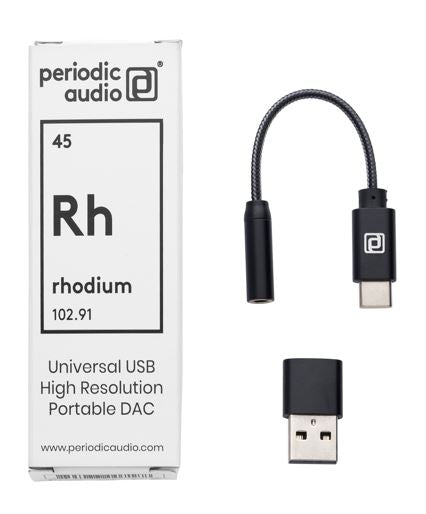
How does Rhodium stack up against a high-end DAC?
25-11-2022We put Rhodium through the paces against the well-know AudioQuest Dragonfly Black. The results were quite informative...
The AudioQuest Dragonfly Black is a USB headphone DAC/amp, and is often recommended at the low price of $129. AudioQuest is a legendary name in the audiophile world, so how does our little Rhodium DAC stack up against the much more expensive DAC from this big brand? Here we go (it's going to be thick with numbers and charts - hang on!)
Let's start with some basics. The Black runs at up to 24 bit, 96 kHz. It's a fairly large, USB Flash-drive style device with a type A output. Use on portable devices mandates a type A female to type C male cable. Not too convenient. It claims 1.2V output.
The Rhodium? It runs up to 32 bit, 384 kHz. Tiny - 7mm in diameter, like a very short adapter cable. Comes with USB C natively so it plugs into your portable device. It includes a tiny type C to type A adapter if needed. States 31 mW into 32 Ohms - about 1 Vrms output.

Let's start with the measured bandwidth and output voltage. On the AudioPrecision, we set the digital output to -1 dBFS (almost full scale), plugged in a 32 Ohm load, and measured the output voltage. Green is for AudioQuest, Red for Rhodium. This is the result we see - TWICE the voltage swing for Rhodium as the Black! That's FOUR TIMES the measured power (power is voltage squared divided by resistance; twice the voltage means 4X the power).
And the bandwidth is pretty obvious, too. The Black starts rolling off at 20 Hz on the low end, and 20 kHz at the top end. Rhodium? Ruler flat (well, within the sampling rate limit of 96 kHz so we could be fair to the Black - it's actually flat to 80 kHz).
How about THD - distortion? Well - we ran that as well. Same settings as above. In this case, the green traces are again for the Black, red for Rhodium.
Once again, we see the Rhodium decisively trouncing the Black. A lot lower distortion through the midbass, midrange, and treble - 95% of the audio bandwidth. Only down deep below 20 Hz do they get close to each other (with Rhodium still lower THD).

So what all does this mean? Well, you can spend $129 for a bigger, lower power, higher distortion, lower sampling and bit depth DAC that's not convenient for phones or portable use. Or you can spend $49, get four times the power, half or less the distortion, much higher sampling rate and bit depth, and more convenience.
We think the choice is pretty logical. Rhodium. The highest performance mini dongle DAC you can find.
